Get Year From Date In Excel

Extracting the Year from a Date in Excel

When working with dates in Excel, it’s common to need to extract specific parts of the date, such as the year, month, or day. Extracting the year from a date can be useful for various purposes, including data analysis, filtering, and formatting. In this article, we’ll explore how to get the year from a date in Excel using different methods.
Using the YEAR Function

The most straightforward way to extract the year from a date in Excel is by using the YEAR function. This function takes a date as an argument and returns the year as a four-digit number. The syntax for the YEAR function is:
YEAR(date)
Where “date” is the cell containing the date from which you want to extract the year.
📝 Note: The date should be in a format that Excel recognizes as a date. If the date is in text format, you may need to convert it to a date format first.
For example, if you have a date in cell A1, you can use the YEAR function in cell B1 like this:
=YEAR(A1)
This will return the year of the date in cell A1.
Using the TEXT Function

Another way to extract the year from a date is by using the TEXT function in combination with the date formatting codes. The TEXT function converts a value to text in a specified format. To extract the year, you can use the “yyyy” format code, which stands for a four-digit year. The syntax for the TEXT function is:
TEXT(date, "yyyy")
Where “date” is the cell containing the date from which you want to extract the year.
For example:
=TEXT(A1, "yyyy")
This will return the year of the date in cell A1 as a four-digit text string.
Using the INT and DATE Functions

If you prefer not to use the YEAR or TEXT functions, you can also extract the year from a date using the INT and DATE functions. The INT function rounds a number down to the nearest integer, and the DATE function returns a date given the year, month, and day. The syntax is:
=INT((A1-DATE(YEAR(A1),1,1))/365.25)
However, this method is more complex and may not be as accurate due to leap years.
Comparing Methods

Each of these methods has its use cases. The YEAR function is the most straightforward and usually the best choice. The TEXT function is useful when you need the year as text, for example, to concatenate with other text strings. The INT and DATE functions method, while more complex, can be useful in specific scenarios where the YEAR function is not applicable.
Common Scenarios and Tips

- Handling Text Dates: If your dates are in text format, you might need to convert them to a date format Excel recognizes. You can use the DATEVALUE function for this purpose. - Leap Years: When calculating years, especially in financial or calendrical calculations, remember to account for leap years to ensure accuracy. - Date Formats: Excel stores dates as serial numbers, starting from January 1, 1900. This is why the YEAR function works by extracting the year component from this serial number.
| Method | Formula Example | Description |
|---|---|---|
| YEAR Function | =YEAR(A1) | Extracts the year from a date directly. |
| TEXT Function | =TEXT(A1, "yyyy") | Converts a date to a text string representing the year. |
| INT and DATE Functions | =INT((A1-DATE(YEAR(A1),1,1))/365.25) | A complex method to extract the year, considering leap years. |

To summarize, extracting the year from a date in Excel can be efficiently done using the YEAR function, the TEXT function for text output, or more complex formulas involving the INT and DATE functions. Each method has its applications, and choosing the right one depends on the specific requirements of your task.
What is the simplest way to extract the year from a date in Excel?

+
The simplest way is by using the YEAR function, which directly returns the year from a given date.
How do I extract the year from a date in text format?

+
First, convert the text date to a date format using the DATEVALUE function, and then apply the YEAR function.
What is the difference between using the YEAR function and the TEXT function with “yyyy” format?

+
The YEAR function returns the year as a number, while the TEXT function with “yyyy” format returns the year as a text string.



